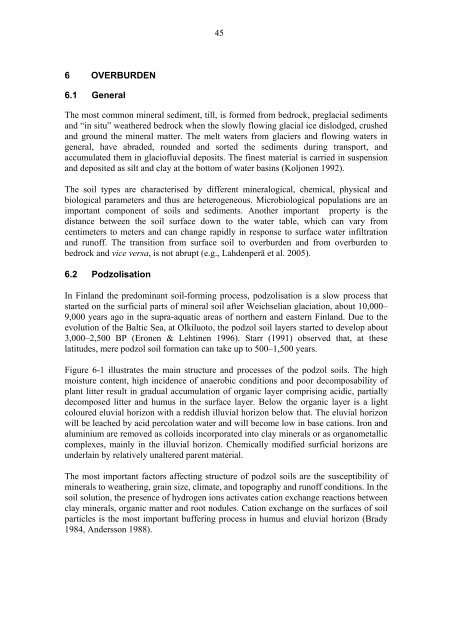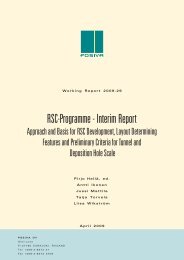Olkiluoto Biosphere Description 2006 (pdf) (4.1 MB) - Posiva
Olkiluoto Biosphere Description 2006 (pdf) (4.1 MB) - Posiva
Olkiluoto Biosphere Description 2006 (pdf) (4.1 MB) - Posiva
You also want an ePaper? Increase the reach of your titles
YUMPU automatically turns print PDFs into web optimized ePapers that Google loves.
456 OVERBURDEN6.1 GeneralThe most common mineral sediment, till, is formed from bedrock, preglacial sedimentsand “in situ” weathered bedrock when the slowly flowing glacial ice dislodged, crushedand ground the mineral matter. The melt waters from glaciers and flowing waters ingeneral, have abraded, rounded and sorted the sediments during transport, andaccumulated them in glaciofluvial deposits. The finest material is carried in suspensionand deposited as silt and clay at the bottom of water basins (Koljonen 1992).The soil types are characterised by different mineralogical, chemical, physical andbiological parameters and thus are heterogeneous. Microbiological populations are animportant component of soils and sediments. Another important property is thedistance between the soil surface down to the water table, which can vary fromcentimeters to meters and can change rapidly in response to surface water infiltrationand runoff. The transition from surface soil to overburden and from overburden tobedrock and vice versa, is not abrupt (e.g., Lahdenperä et al. 2005).6.2 PodzolisationIn Finland the predominant soil-forming process, podzolisation is a slow process thatstarted on the surficial parts of mineral soil after Weichselian glaciation, about 10,000–9,000 years ago in the supra-aquatic areas of northern and eastern Finland. Due to theevolution of the Baltic Sea, at <strong>Olkiluoto</strong>, the podzol soil layers started to develop about3,000–2,500 BP (Eronen & Lehtinen 1996). Starr (1991) observed that, at theselatitudes, mere podzol soil formation can take up to 500–1,500 years.Figure 6-1 illustrates the main structure and processes of the podzol soils. The highmoisture content, high incidence of anaerobic conditions and poor decomposability ofplant litter result in gradual accumulation of organic layer comprising acidic, partiallydecomposed litter and humus in the surface layer. Below the organic layer is a lightcoloured eluvial horizon with a reddish illuvial horizon below that. The eluvial horizonwill be leached by acid percolation water and will become low in base cations. Iron andaluminium are removed as colloids incorporated into clay minerals or as organometalliccomplexes, mainly in the illuvial horizon. Chemically modified surficial horizons areunderlain by relatively unaltered parent material.The most important factors affecting structure of podzol soils are the susceptibility ofminerals to weathering, grain size, climate, and topography and runoff conditions. In thesoil solution, the presence of hydrogen ions activates cation exchange reactions betweenclay minerals, organic matter and root nodules. Cation exchange on the surfaces of soilparticles is the most important buffering process in humus and eluvial horizon (Brady1984, Andersson 1988).
















